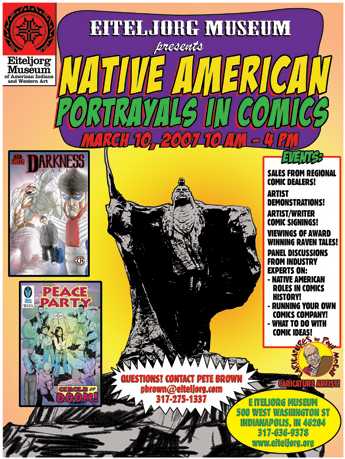Peter,
Thanks for asking me about your proposed exhibition on Native American portrayals in comics.
I thought the two shows I participated in--at the Eiteljorg Museum and the Montclair Art Museum--went well. Naturally I'd like to participate in similar shows but on a grander scale: with more press coverage and attendance.
But it sounds as if you're looking to do something new, not merely repeat what's been done before. Therefore, some ideas:
Superman, Batman, Captain Marvel, et al. as chiefs: You could display the covers of old comics from Greg Reinhardt's collection. Juxtapose them with paintings and photographs of traditional chiefs from non-Plains tribes, and with photographs or videos of modern-day tribal leaders. This would show that most Indian leaders don't fit the mold of the stoic Plains chief in a headdress.
The text accompanying these images could deconstruct the comic-book covers and tell viewers why these images were so prevalent. For instance, the "chief" stereotype helped depict Indians as a colorful and exotic remnant of the past. By favoring traditional chiefs over modern-day chiefs, the covers reinforced the idea that Indians were vanishing or had vanished. And that we no longer had to think of them as real or address their concerns and problems.
You could compare a selection of images of Indian warriors in comics--Turok, Butcher, Scout, Warpath, Ripclaw--to the reality of being an Indian warrior: preparing days in advance, praying and fasting, seeking signs and omens, counting coup rather than actually killing people. Similarly, you could compare a selection of mystical Indian characters--Coyote, Shaman, Talisman, Manitou Raven--to the roles and work of actual Indian medicine men and priests.
The "white Indian" phenomenon: A display could compare "white Indians" such as Firehair, White Indian, and Scalphunter to actual whites taken captive and raised by Indians. This could explore why such characters were so popular: because publishers pandered to their white readers, who couldn't imagine that Indians were real people with complex lives, personalities, hopes and dreams.
Yakari: This Belgian comic-book series features the adventures of a young Sioux boy. From what I've seen, it's almost devoid of any real Sioux culture. A display could compare Yakari's circumstances to those of an actual Sioux boy growing up in traditional times. This would show how comics tend to ignore the complexity and depth of Indian cultures.
NFL SUPERPRO #6: A display could blow up images from this comic and point out the mistakes and stereotypes one by one. The accompanying text and photographs could show viewers what the Hopi and Navajo cultures portrayed in the comics are really like. You could do similar analyses with other notorious Indian comics--e.g., SCALPED, COWBOYS & ALIENS--as well.
Wyatt Wingfoot and Jim Thorpe: The Wingfoot character is clearly based on Jim Thorpe. A display could compare and contrast the two, showing the parallels between the real-life athlete and the fictional character. (Consider how Stan Lee presumed that a college-bound Indian had to come from a super-advanced civilization.)
The Super Friends' Apache Chief: Compare and contrast to real Apache chiefs and warriors, both traditional and modern.
Jack Kirby's ETERNALS: Compare and contrast to Inca and Mesoamerican mythology, art, and architecture.
Little Sure Shot and Johnny Cloud: Compare and contrast to actual Indian military veterans.
These Indian-style origins could be just one or two pages long. You could compile them into a separate publication--a comic-book handout like the one the Montclair produced--or include them in the exhibit catalog. The creators might be willing to do this free, or you could pay them a small stipend.
That's all for now. I'll probably think of something else as soon as I send this. Oh, well!
Rob
P.S. For more on the subject, see Comic Books Featuring Indians.


1 comment:
Response from Professor Greg Reinhardt:
Good grief: Rob is a wellspring of wonderfully creative ideas--what brainstorming! His ideas alone will give us loads to talk about today.
Post a Comment